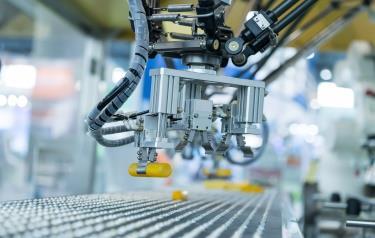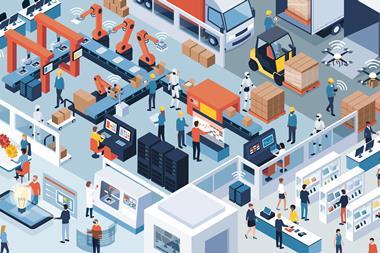Generative AI promises to transform supply chains – enhancing efficiency and data quality, reducing labour costs, and much more. But over-reliance on this new tech could expose the entire chain to new weaknesses in accuracy, security and fairness.
AI is currently being viewed as a catchall solution to everything from cancer diagnostics to fraud detection, from predicting stock market trends to personalised education.
Risk professionals are not immune to such optimism. While AI has already shown its worth in predictive analytics and operational risk management, there is one potential area of use in particular that is sparking interest among risk managers — the supply chain.

In January, an IDC report predicted that by 2026, 60% of APAC companies will use generative artificial intelligence (GenAI) tools to support core supply chain processes. “The integration of AI within supply chains signifies a crucial evolution, anticipating an accelerated adoption of advanced technology,” says Rani Ratna, senior research manager at IDC Asia/Pacific, regarding the report’s findings.
“This shift is poised to bring substantial improvements, ranging from heightened productivity to more engaged workforces. The immediate focus is on use cases that enhance short-term productivity and efficiency, with a long-term vision encompassing broader ecosystem integration and an increased emphasis on sustainability,” Ratna adds.
So, is AI the remedy for long-standing supply chain issues facing risk managers, or just a placebo — or worse, a snake oil cure?
WHAT CHALLENGES CAN AI ADDRESS?
“AI is not new to supply chain practice,” notes Ayoub Abielmona, EY Global GenAI supply chain leader. “It has been solving supply chain headaches for decades, with its ability to automate repetitive tasks, detect patterns, and make predictions based on historical data.
“It has played a significant role in various areas, such as inventory optimisation, route planning, production scheduling, forecasting supply and demand, warehouse management through robotics, and customer service via chatbots.”
Abielmona asserts that while these tools have been effective in providing analysis and recommendations, they have not yet gone far enough to help supply chains become more agile and resilient in the face of market disruption and global volatility.
“Many of the robots we see deployed in factories and warehouses today are powered by machine learning.”
Tess Frenzel, a senior principal in Gartner’s supply chain practice, says there are many challenges that supply chain leaders are trying to tackle with AI. “These include making better predictions to manage risks and inventory, supporting and automating decisions, and improving data quality,” she says.
“Some supply chains are also looking to AI to reduce labour costs. Many of the robots we see deployed in factories and warehouses today are powered by machine learning.”
For Frenzel, how effective these tools are in addressing supply chain challenges depends on the digital maturity of an organisation and a team’s willingness to embrace the technology. “Supply chains need the right culture and digital infrastructure for successful AI adoption,” she says.
POTENTIAL PITFALLS
According to Abielmona, while AI risks and pitfalls have always existed, generative AI increases the risks in four key areas: trust and accuracy, privacy and security, fairness and bias, and legal and regulatory compliance.
“To address these concerns, AI systems should be developed under a responsible AI governance framework, with policies and procedures that promote accountability across the development cycle, protect data privacy, ensure compliance with evolving regulations, and mitigate potential biases,” she says.
“It’s imperative that AI systems are built with appropriate levels of transparency and explainability regarding their purpose, design and deployment to ensure end users can evaluate and correctly employ AI outputs. The decision criteria of AI systems should be reasonably understood by human operators so that results can be easily explained, validated, and challenged if necessary, for accuracy and bias.”
“If you don’t fix your data quality issues before implementing AI use cases, you won’t get the most out of your investment.”
Most traditional AI use cases require historical data, and when past trends no longer hold true in the present, AI-based forecasting can mislead supply chains.
“We’ve seen that in real time, with economic forecasts being largely wrong over the past three years,” Frenzel says. “Having a human in the loop prepared to override a system if things go awry and provide oversight for edge cases is critical for risk mitigation.”
Frenzel also pointed out that the phrase “garbage in, garbage out” holds true for AI in supply chain management. “If you don’t fix your data quality issues before implementing AI use cases, you won’t get the most out of your investment.”
SELF-DRIVING ECOSYSTEMS
Abielmona predicted that over the next five to 10 years, as AI becomes embedded in every software solution, supply chains will shift from rigid, linear silos to fully autonomous, self-driving ecosystems that can operate independently, learn from their environment, and make decisions with minimal human intervention.
“This journey towards autonomy, while contemplated for decades, is now possible due to recent advances in technologies like GenAI and the increased speed and access to multi-modal data that it unlocks,” Abielmona said.
“Without addressing the data access problem, AI’s rapid progress may stall”
“Autonomous supply chains will go beyond predicting demand fluctuations and making recommendations — they will execute tasks on our behalf, such as adjusting production schedules, rerouting logistics in response to disruptions, and even negotiating with suppliers and customers.”
Frenzel said that according to Gartner’s Hype Cycle for Supply Chain Strategy, AI will become widely productive in supply chain management over the next five to 10 years. “Trends for AI that supply chain leaders should continue to monitor include the energy and resource costs associated with AI and the threat of a ‘data wall’ undermining AI’s progress.
“AI-supported tools are energy and resource-intensive. Moreover, much of the high-quality data used to train systems like large language models is expected to be depleted in the coming years. Without addressing the data access problem, AI’s rapid progress may stall,” Frenzel warned.














No comments yet